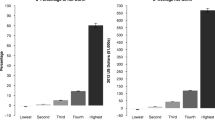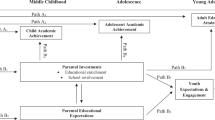Abstract
In this study, we propose that children who have a savings account may be more likely to have higher math scores than children without a savings account. We find that children’s savings accounts are positively associated with math scores. Children with savings accounts on average score almost nine percent higher in math than children without a savings account. Further, results suggest that children’s savings accounts fully mediate the relationship between household wealth and children’s math scores. However, household wealth moderates the mediating relationship. We find math scores of low-wealth children increase by 2.13, middle-wealth children’s increase by 4.36, while high-wealth children’s increase by 6.59 points. Policy implications are discussed.


Similar content being viewed by others
Notes
NAEP—the nation’s report card—provides a common set of standards for assessing performance.
References
ASPIRE. (2004). Aspire act/kids counts press conference. Retrieved July 22, 2004, from http://www.assetbuilding.org/AssetBuilding/Download_Docs/Doc_File_1019_1.pdf.
Axinn, W., Duncan, G., & Thornton, A. (1997). The effects of parents’ income, wealth, and attitudes on children’s completed schooling and self-esteem. In G. Duncan & J. Brooks-Gunn (Eds.), Consequences of growing up poor (pp. 518–540). New York, NY: Russell Sage Foundation.
Baron, R. M., & Kenny, D. A. (1986). The moderator-mediator variable distinction in social psychological research: Conceptual, strategic, and statistical considerations. Journal of Personality and Social Psychology, 51(6), 1173–1182.
Beutler, I., & Dickson, L. (2008). Consumer economic socialization. In J. J. Xiao (Ed.), Handbook of consumer finance research. New York, NY: Springer.
Beverly, S. G., & McBride, A. (2003). A framework of asset-accumulation stages and strategies. Journal of Family and Economic Issues, 24(2), 143–156.
Brooks-Gunn, J., & Duncan, G. J. (1997). The effects of poverty on children. Children and Poverty, 7(2), 55–71.
Duncan, G., Yeung, W. J., Brooks-Gunn, J., & Smith, J. (1998). How much does childhood poverty affect the life chances of children? American Sociological Review, 63(3), 406–423.
Eccles, J., Wigfield, A., Harold, R. S., & Blumenfeld, P. (1993). Age and gender differences in children's self- and task perceptions during elementary school. Child Development, 64(3), 830–847.
Elliott, W. (2008). Children’s college aspirations and expectations: The potential role of college development accounts (CDAs). Children and Youth Services Review, 31(2), 274–283.
Fry, T. R. L., Mihajilo, S., Russell, R., & Brooks, R. (2008). The factors influencing saving in a matched savings program: Goals, knowledge of payment instruments, and other behavior. Journal of Family Economic Issues, 29, 34–250.
Greenwald, R., Hedges, L. V., & Laine, R. D. (1996). The effect of school resources on student achievement. Review of Educational Research, 66(3), 361–396.
Guo, S. (2005). Analyzing grouped data with hierarchical linear modeling. Children and Youth Services Review, 27, 637–652.
Han, C. K., & Sherraden, M. (2009). Attitudes and saving in individual development accounts: Latent class analysis. Journal of Family and Economic Issues, 30(3), 226–236.
Haveman, R., & Wilson, K. (2007). Economic inequality in college access, matriculation, and graduation. In S. Dickert-Conlin & R. Rubenstein (Eds.), Economic inequality and higher education: Access, persistence, and success. New York, NY: Russell Sage Foundation.
Hofferth, S., Davis-Kean, P. E., Davis, J., & Finkelstein, J. (1997). The child development supplement to the Panel Study of Income Dynamics: 1997 user guide. Ann Arbor: Survey Research Center, Institute for Social Research, University of Michigan.
Hogarth, J. M., & Anguelov, C. E. (2005). Who has a bank account? Exploring changes over time, 1989–2001. Journal of Family and Economic Issues, 26(1), 7–25.
Johnson, E., & Sherraden, M. S. (2006). From financial literacy to financial capability among youth. Journal of Sociology and Social Welfare, 34(3), 119–145.
Kahneman, D., & Tversky, A. (1979). Prospect theory: An analysis of decision under risk. [Child’s Economics]. Econometrica, 47(2), 263–292.
Lea, S. E. G., Tarpy, R. M., & Webley, P. (1987). The individual in the economy. Cambridge, MA: Cambridge University Press.
Little, R. J. A., & Ruin, D. B. (1987). Statistical analysis with missing data. NY: Wiley.
Lucey, T. A. (2005). Assessing the reliability and validity of Jump$tart survey of financial literacy. Journal of Family and Economic Issues, 26(2), 283–294.
Lunt, P., & Furnham, A. (1996). Economic socialization: The economic beliefs and behaviors of young people. Cheltenham: Edward Elgar.
Mainieri, T. (2006). The panel study of income dynamics child development supplement: User guide for CDS-II Available from http://psidonline.isr.umich.edu/CDS/cdsii_userGd.pdf.
Meeks, C. B. (1998). Factors influencing adolescents’ income and expenditures. Journal of Family and Economic Issues, 19(2), 131–149.
Mishel, L., Bernstein, J., & Allegretto, S. (2005). The state of working America (p. v). Washington, DC: Economic Policy Institute.
Muller, D., Judd, C. M., & Yzerbyt, V. Y. (2005). When moderation is mediated and mediation is moderated. Journal of Personality and Social Psychology, 89(6), 852–863.
National Center for Education Statistics. (2007). The condition of education 2007 (NCES 2007-064). Retrieved October 9, 2008, from http://nces.ed.gov/pubsearch/pubsinfo.asp?pubid=2007064.
Oliver, M. L., & Shapiro, T. M. (2006). Black wealth/white wealth: A new perspective on racial inequality (Vol. Tenth-Anniversary Edition). New York: Routledge.
Orr, A. (2003). Black-white differences in achievement: The importance of wealth. Sociology of Education, 76(4), 281–304.
Peng, T.-C. M., Bartholomae, S., Fox, J. J., & Cravener, G. (2007). The impact of personal finance education delivered in high school and college courses. Journal of Family Economic Issues, 28, 265–284.
Petra, T., & Wolpin, K. (2007). The production of cognitive achievement in children: Home, school, and racial test score gaps. Journal of Human Capital, 1(Winter), 91–136.
Preacher, K. J., & Hayes, A. F. (2004). SPSS and SAS procedures for estimating indirect effects in simple mediation models. Behavior Research Methods, 36(4), 717–731.
Raudenbush, S. W., & Bryk, A. S. (2002). Hierarchical linear models: Applications and data analysis methods (2nd ed.). London: Sage.
Reynolds, A. J., & Gill, S. (1994). The role of parental perspectives in the school adjustment of inner-city black children. Journal of Youth and Adolescence, 23(6), 671–694.
Rosenberg, M. (1986). Conceiving the self. New York: Basic Books.
Sanders, C. K., & Porterfield, S. L. (2009). The ownership society and women: Exploring female householders’ ability to accumulate assets. Journal of Family and Economic Issues. Online First. doi:10.1007/s10834-009-9175-6.
Schreiner, M., & Sherraden, M. (2007). Can the poor save? Saving and asset building in individual development accounts. New Brunswick, NJ: Transaction Publishers.
Seyfried, S. F., & Chung, I.-J. (2002). Parent involvement as parental monitoring of student motivation and parent expectations: Predicting later achievement among African American and European American middle school age students. Social Work with Multicultural Youth, 11(1/2), 109–131.
Shanks, T. W. (2007). The impacts of household wealth on child development. Journal of Poverty, 11(2), 93–116.
Sherraden, M. (1991). Assets and the poor: A new American welfare policy. Armonk, NY: M.E. Sharpe.
Signe-Mary, M., & Sherraden, M. (Eds.). (2008). Asset building and low-income families. Washington, DC: The Urban Institute Press.
Sobel, M. E. (1982). Asymptotic confidence intervals for indirect effects in structural equation models. Sociological Methodology, 13, 290–312.
Sonuga-Barke, E. J. S., & Webley, P. (1993). Children’s saving: A study in development of economic behavior. Hillsdale, NJ: Lawrence Erlbaum.
Thaler, R. H. (1985). Mental accounting and consumer choice. [Economics]. Marketing Science, 4(3), 199–214.
Webley, P., Burgoyne, C. B., Lea, S. E. G., & Young, B. M. (2001). The economic psychology of everyday life. Hove: Psychology Press.
Webley, P., Levine, M., & Lewis, A. (1991). A study in economic psychology: Children’s saving in a play economy. Human Relations, 44(2), 127–146.
Williams, T. R. (2007). The impact of household wealth on child development. Journal of Poverty, 11(2), 93–116.
Winnett, A., & Lewis, A. (1995). Household accounts, mental accounts, and savings behavior: Some old economics rediscovered? Journal of Economic Psychology, 16(1995), 431–448.
Xiao, J. J., & Anderson, J. G. (1997). Hierarchical financial needs reflected by household financial asset shares. Journal of Family and Economic Issues, 18(4), 333–355.
Yeung, J., & Conley, D. (2008). Black–white achievement gap and family wealth. Child Development, 79(2), 303–324.
Yilmazer, T. (2008). Saving for children’s college education: An empirical analysis of the trade-off between the quality and quantity of children. Journal of Family and Economic Issues, 29, 307–324.
Zhan, M. (2006). Assets, parental expectations and involvement, and children’s educational performance. Children and Youth Services Review, 28(8), 961–975.
Zhan, M., & Sherraden, M. (2003). Assets, expectations, and children’s educational achievement in female-headed households. Social Service Review, 77(2), 191–211.
Author information
Authors and Affiliations
Corresponding author
Rights and permissions
About this article
Cite this article
Elliott, W., Jung, H. & Friedline, T. Math Achievement and Children’s Savings: Implications for Child Development Accounts. J Fam Econ Iss 31, 171–184 (2010). https://doi.org/10.1007/s10834-010-9185-4
Published:
Issue Date:
DOI: https://doi.org/10.1007/s10834-010-9185-4




